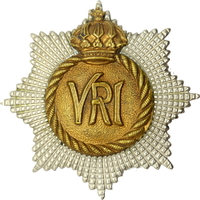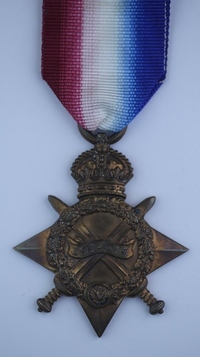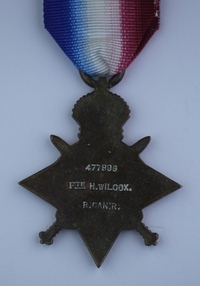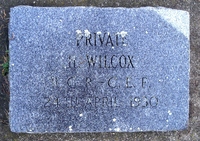
4334 / 477996 Pte Isaac Hamilton Wilcox
The Royal Canadian Regiment
6th Canadian Mounted Rifles (1902)
Canadian Forestry Corps
By: Capt (ret'd) Michael M. O'Leary, CD, The RCR
Isaac Hamilton Wilcox, who went by "Hamilton," was born in Waterford, Norfolk County, Ontario, on 25 Dec 1868.
The Wilcox family can be found in the 1871 Canadian census for Townsend in Norfolk County. Parents Edward S. (43) and Matilda Lucy (nee Durphy, 36) have five children at home: Anna A. (15), Edward H. (13), Mary L. (11), George A. (6), and Isaac H. (4). An older sister, Ursula (20) was entered on the census form but then struck through and annotated "Married and left home." Two others are named in the household, and are possibly lodgers.
By the time of the 1891 Canadian census, Hamilton Wilcox (23) was living in the Village of Waterford in North Norfolk. He is shown as a lodger in the home of his sister and brother-in-law, John and Mary Martin, and their four children. Wilcox's trade is noted as Cheesemaker. He likely works for John Martin, who is shown as a Cheese Manufacturer with one employee.
Wilcox can be found in the regimental enrolment ledgers held in the archives of The Royal Canadian Regiment Museum. At the age of 31 years, 11 months, he enlisted in the Permanent Force with The Royal Canadian Regiment (The RCR) at Toronto, Ont., on 26 Nov 1900. He was assigned the regimental number 4334. Soon after enlisting at Toronto, Wilcox was transferred to the regimental depot at Quebec on 15 Mar 1901.
While serving as a soldier of The RCR, Wilcox attested for service in South Africa with the 6th Canadian Mounted Rifles (C.M.R.) on 28 Apr 1902. With a noted age of 34, Wilcox was described on his medical examination form as 5-feet 8-inches in height, weighing 140 pounds, with a 35-inch chest, fair muscular development, fair intelligence, sanguine temperament, fair complexion, brown hair, and blue eyes. He was pronounced fit with no noted medical issues. With the 6th C.M.R., Wilcox had the regimental number 35.
The 3rd, 4th, 5th, and 6th Canadian Mounted Rifles arrived in South Africa on 18 Jun 1902, after the Boer surrender, and departed a few weeks later on 2 July. Their service resulted in no medal entitlements.
On 15 Sep 1908, Wilcox made an application under The Volunteer Bounty Act, 1908, with respect to service in the South African War. To support his claim, the relevant paragraph of his application read:
"I was enlisted in the 6th Canadian Mounted Rifles and arrived in South Africa for the purpose of serving in the War against the Boers, but owing to the close of the War, I was not on active service. My discharge from said Corps is enclosed herewith. At the time of my said enlistment I was domiciled at Quebec in the Dominion of Canada."
Noting in the form's "Applicant's Declaration" that he was a soldier of The RCR at Quebec, Wilcox completed his declaration at St. Louis Barracks in front of Major A.O. Fages, Commanding No. 5 Regimental Depot, The RCR.
Continuing to serve with The RCR, Wilcox completed four consecutive three-year terms of service. He chose not to re-engage for a fifth period of service and discharged from the Permanent Force on 25 Nov 1912. His character on discharge was recorded as "Very Good."
A little over two weeks after leaving the Regiment, Wilcox re-enlisted at Toronto on 12 Dec 1912.
In the late summer of 1914, with the outbreak of war in Europe, things moved quickly for the soldiers of The RCR. Since 1905, following the departure of the last British garrison battalion, The RCR had expanded in size and a new regimental headquarters and six new companies, numbered 1 through 6, were located at Halifax, Nova Scotia. By 1914, the companies in Halifax were lettered "A" through "F" and the outlying companies were "G" (Quebec, P.Q.), "H" (Fredericton, N.B.), "I" (Toronto, Ont.), and "K" (London, Ont.). "L" Company was established in 1914 at Esquimalt and remained there throughout the War.
At the outbreak of war, the outlying companies of the Regiment were recalled to join the main body at Halifax. After a brief period of duty in the Halifax defence complex, the Regiment was asked to serve in Bermuda on a year of garrison duty to relieve the British Army battalion at that garrison.
On 11 Sep 1914, The Royal Canadian Regiment sailed for Bermuda. On arriving at the island station, the Regiment relieved the 2nd Battalion, Lincolnshire Regiment, which sailed immediately for England.
Wilcox appears on the regimental paylist for "D" Company at Bermuda in October, 1914. At the beginning of that month, the Regiment completed a reorganization of its original ten companies plus four provisional companies that had arrived in Bermuda into a doctrinal 8-company structure. (This would later be reorganized again into a new 4-company organization for infantry battalions.) As part of this re-organization, the original "G" (Quebec) and "H" (Fredericton) Companies became the new "D" Company.
Another major change for Wilcox and the soldiers of The RCR in October 1914 was a change from Permanent Force rates of pay to the Canadian Expeditionary Force (C.E.F.) rates of pay. This doubled the pay received by some soldiers, while others who had served longer saw smaller but still significant increases.
On 12 Aug 1915, The RCR was relieved in turn by the arrival of the 38th Overseas Battalion from Canada. The RCR returned to Halifax for a stay of only a week. During this time, the Regiment was re-attested for overseas service. Although The RCR had just spent a year in Bermuda, there were concerns regarding the applicability of the soldiers' Permanent Force enlistments for wartime deployments. This was, perhaps, prompted by the idea that a man on a P.F. three-year engagement could choose not to re-engage and the Government would be obligated to bring him home. Enlistment in the C.E.F., on the other hand, was for the "Duration of War." Accordingly, the soldiers of The RCR were re-attested, signing C.E.F. attestation papers in August 1915 before sailing for Europe.
Hamilton Wilcox attested for service in the C.E.F. with The RCR at Halifax, N.S., on 24 Aug 1915. A 47-year-old cheesemaker, Wilcox was described on his attestation paper as 5-feet 8 1/2-inches tall, with a 36-inch chest, a fair complexion, grey eyes, and light brown hair. His religious denomination was not recorded. Wilcox identified his brother, Mr. H. Wilcox, 68 Farley St., Toronto, Ont., as his next of kin. On his attestation form, Wilcox noted his prior regimental service from 1900 to 1912. (Wilcox's place of birth was mistakenly recorded on this form as Waterloo, Ont.)
On 26 Aug 1915, The RCR sailed from Halifax aboard the S.S. Caledonian, the same ship that had brought them home from Bermuda. Disembarked at Plymouth, England, on 6 Sep 1915, the Regiment went to Shorncliffe for training.
Wilcox received a new C.E.F. service number on 28 Sep 1915 to replace the regimental number he was assigned on enlisting with The RCR. While serving in the C.E.F., his service number would be 477996. Since the Regiment received its C.E.F. numbers while at full strength and not as they were recruited, it had the interesting effect that the soldiers of the Regiment at the time were renumbered in alphabetical order.
On the reorganizing of the Regiment for overseas service, Wilcox was posted from "D" Company to the Base Company on 9 Oct 1915. Two weeks later, on 26 Oct 1915, he is noted as belonging to "C" Company.
The RCR crossed the English Channel on 1 Nov 1915, entering the theatre of war at Boulogne, France. During November and December of 1915 the Regiment prepared for service in the trenches, with companies rotating in the lines for training and a period of providing working parties before entering the line as a battalion at the end of December. The first months of 1916 saw the Regiment in the steady rotation through front line trenches, support trenches, and reserve positions that was the fundamental experience of the infantry in the Great War.
Wilcox's service in the infantry came to an end in August 1915. He was briefly attached to 3rd Canadian Division Headquarters for fatigue duty from 27 to 30 Aug 1916. After this, he was Classified "Permanent Base Duty" and transferred to the Canadian Base Depot (C.B.D.) he remained for a week and a half before being classified medical category "C" and noted as "overage" on 11 Sep 1916. Wilcox was transferred to the Canadian Casualty Assembly Centre (C.C.A.C.) at Folkestone. This was a centre where wounded or otherwise injured soldiers were assessed for either further treatment or return to duty.
A Medical Board at Folkestone examined Wilcox on 13 Sep 1916. His disability was noted as "Weakness in back" and "over-age." Wilcox's condition described as "Has been 11 months in France. He says that he can't carry the pack for over two miles in a route march. He says his age is 52, … his arteries are hardened … right foot, bunions …" He was determined to be "Fit for Permanent Base Duty."
On 14 Sep 1916, Wilcox was attached from the C.C.A.C. to the RCR & PPCLI Depot at Caesar's Camp, East Sandling. This was a short-lived depot unit that supported those two named regiments with drafts of reinforcements. It was created on 13 Feb 1916 by separating it from the 11th Reserve Battalion, and it was disbanded on 20 Jan 1917 when it was absorbed into the 7th and 26th Reserve Battalions.
Wilcox's parent unit changed again on 7 Feb 1917 when he ceased to be attached to 7th Res. Bn., Seaford, from the C.C.A.C. on transfer with other personnel of The RCR to the 26th Res. Bn. at Bramshott.
At the age of 52, having served for over ten months in France, Wilcox was re-examined by a Standing Medical Board at Bramshott on 19 Feb 1917. The Board's brief report stated "This man hurt his back while in France, and was disabled from marching with pack. He has now recovered, Heart normal, and otherwise fit except varicosa." The Board gave Wilcox a medical category of "Bi" (i.e., men who were fit for employment in labour, forestry, and railway units).
On 10 Mar 1917, Wilcox was attached to the 26th Res. Bn. from the Nova Scotia Regimental Depot (N.S.R.D.). This change marks the creation of these provincially named depots, the assignment to them of applicable soldiers, and the attachment of those troops back to units under the Depot's control.
The N.S.R.D. was part of the new regionally based reinforcement system, with named Depots taking in troops from new battalions or drafts of reinforcements raised in those areas in Canada and providing reinforcement drafts to similarly designated fighting units. The RCR, having been headquartered in Halifax in the decade before the War, was associated with the N.S.R.D. These Depots also became the parent unit for any soldiers returned to England from their affiliated battalions in France and Flanders.
In March, April, and May of 1917, Wilcox moved between units within the N.S.R.D. This ended on 12 May 1917, when he was struck off strength of the N.S.R.D. on transfer to the Canadian Railway Troops (C.R.T.) at Purfleet. As a Private in the CRT, his rank was then shown as "Sapper."
Wilcox only spent two weeks with the Depot of the C.R.T. On 24 May 1917, he was struck off strength and transferred to the Canadian Forestry Corps (C.F.C.) at Sunningdale. Four days later he moved again, when he was posted on 28 May 1917 from the Base Depot C.F.C. to No. 132 Company, District No. 52 at Mansfield, Nottinghamshire.
From No. 132 Coy, C.F.C., Wilcox was sent to attend the Corps School at Portslade, Brighton, from 29 Jan to 1 Mar 1918. He returned to the Company but only until 24 May 1918 when he was struck off strength to the C.F.C. Depot at Sunningdale. Returning to No. 132 Coy. for June and most of July, Wilcox was finally struck off strength on 22 Jul 1918 when he returned to the Base Depot at Sunningdale for a medical board.
That Medical Board was conducted at Sunningdale on 29 Jul 1918. It gave Wilcox a category of "Biii" (i.e., men capable of sedentary work as clerks). He was again examined by a Medical Board at Sunningdale on 12 Aug 1918 for conditions of myalgia and varicose veins. Notes from the Board's report include:
"History of the case:— Has been in regular army since South African War. Signed up in present war in CEF, June 1915 (sic). In France 13/12/15, sent to England from the Infantry as unable to carry on. He was buried at Ypres, 1916, July, since which time he dates his myalgia and "pains all over." A bit previous to this varicose veins in right leg began to bother him, gradually he found himself unable to do any marching or walking owing to swelling and ache in right leg."
"Present Condition:— Age is 53. Condition not good. There is arterio sclerosis. There is no limitation of spinal movements of area, acute tenderness but he describes it as a continual or intermittent ache across lumbar region, the shoulders and hips are similarly affected. There is marked varicose condition of right leg from ankle to thigh. The left leg is free from varicose veins but is affected by rheumatism. Marked bursitis on right foot but he doesn't complain from this. Is able to walk only short distance. The heart is negative."
Wilcox was again recommended for medical category "Biii", and this was considered likely to be raised within six months.
It was a month after his medical board, on 10 Sep 1918, that Wilcox was attached to the Canadian Discharge Depot (C.D.D.) at Buxton for return to Canada. Two weeks later, on 23 Sep 1918, he ceased to be attached to C.D.D. Buxton on embarking for Canada. His return was noted with the limitation of "No suitable employment in England."
Wilcox returned to Canada at Quebec on 7 Oct 1918 aboard the S.S. Cardiganshire. He was taken on the strength of No. 2 District Depot at Toronto and posted to the Casualty Company on arrival. Within days of his return, he was placed on leave with subsistence allowance from 9 Oct to 22 Oct 1918.
As part of his discharge proceedings, Wilcox was medically examined at Park School Barracks, Toronto, Ont., on 25 Oct 1918. The diagnoses the exam confirmed were (1) Arterio sclerosis and (2) Varicose veins. The first of these was considered to predate his enlistment while the second was dated to a injury sustained whilst jumping a trench on 2 Jul 1916.
His condition was described as:
"Subjective:— Pains in back and legs, worse on exertion, shortness of breath and dizziness on exertion.
"Objective:— Body not well nourishes, muscles very poor tone, age 53, looks his age. Heart apex beat in nipple line, no enlargement. Rate 88 sitting, respiration 18, on exertion touching the floor ten times pulse 130, respiration 22, returns to [??] in 1 minute. Systolic blood pressure 155, diastolic 110. Arteries thickened and tortuous, no nodules felt. Lungs— Respiration full and equal, no adventitious sounds. Digestive, teeth poor, has plates. Throat clear. No digestive disturbance. Nervous, slight tremor hands, no tombergism, knee jerks exaggerated.
"Subjective:— When walking any distance 1 mile or walks quickly becomes painful and tired and leg and thigh feels numb.
"Objective:— Large varicosity about right knee joint, internal saphenous greatly enlarged and marked varicosity of veins of right leg. Varicosity also, veines right groin. Leg or foot not swollen or aedemtous. Movement knee joint normal. Large bunion right great toe joint. Other symptoms apparently normal. Incapacity due to arterio sclerosis and 2 varicose veins right leg."
Both of Wilcox's medical conditions were considered permanent and it was noted that he had never been hospitalized for treatment. The Medical Board which reviewed his case placed him in medical category "E" (i.e., men unfit for A, B or C, and not likely to become fit within six months) and to be discharged as medically unfit for further military service.
At the age of 53, Wilcox was discharged from the C.E.F. as Medically Unfit on 1 Nov 1918. He received 91 days Post Discharge Pay and a clothing allowance. His conduct and character on discharge were noted as "Very Good."
On discharge from the C.E.F., Wilcox received his Last Pay Certificate covering the period from 1 Oct to 1 Nov 1918. Having carried forward a pay balance of $450.30, plus another 32 days' pay ($35.20), Clothing Allowance ($35.00), and subsistence allowance ($12.00), he was paid a total of $532.50. This sum was about the amount a private in the C.E.F. would earn (pay plus field allowance) over 16 months.
For his service in the C.E.F., Wilcox was entitled to receive the 1914-15 Star, the British War Medal, and the Victory Medal. These were despatched to him at Waterford, Ont., in May and June of 1921.
By the time of the 1921 Canadian census, Wilcox was again living in Waterford, Ont., with his sister and brother-in-law, John and Mary Martin. The Martins only had one child still at home, 19-year-old Marjorie. Martin's trade is shown as "Merchant" while Wilcox's is listed as "Capper."
On 24 Apr 1930, Hamilton Wilcox died at the Christie Street Hospital in York, Ontario. He was 62 years old. His last occupation recorded on his registration of death was "Caretaker." The cause of his death was noted as "myocardial failure" which was not attributed to his military service. Wilcox's remains were shipped to Waterford, Ont., and he is buried in Greenwood Cemetery in that community. His simple grave stone reads "Private H. Wilcox, RCR – CEF, 24th April 1930."
Pro Patria
Visit a randomly selected page in The O'Leary Collection (or reload for another choice):
- The O'Leary Collection; Medals of The Royal Canadian Regiment.
- Researching Canadian Soldiers of the First World War
- Researching The Royal Canadian Regiment
- The RCR in the First World War
- Badges of The RCR
- The Senior Subaltern
- The Minute Book (blog)
- Rogue Papers
- Tactical Primers
- The Regimental Library
- Battle Honours
- Perpetuation of the CEF
- A Miscellany
- Quotes
- The Frontenac Times
- Site Map
QUICK LINKS
The O'Leary Collection—Medals of The Royal Canadian Regiment
Newest additions:
![]()
![]() SB-12725 Private Henry "Hank" Ard
SB-12725 Private Henry "Hank" Ard ![]()
WIA at Hill 187, Died of Wounds in Japan
![]()
![]() 2355331 Lance Corporal Albert Lorking
2355331 Lance Corporal Albert Lorking
Wounded in action, later a War Amps representative.
![]()
![]() 4334 / 477996 Pte Isaac Hamilton Wilcox
4334 / 477996 Pte Isaac Hamilton Wilcox
Permanent Force, South Africa, and C.E.F.
![]()
![]() 477019 Private Harold Ashcroft
477019 Private Harold Ashcroft
Transferred to the Tunnelers.
![]()
![]() 734231 Private Clark D. Thompson
734231 Private Clark D. Thompson ![]()
The older Thompson brother, killed in action.
![]()
![]() 733849 Private Norman Parker Thompson
733849 Private Norman Parker Thompson
The younger Thompson brother; post-war service in the Special Guard.
![]()
![]()
![]() A305 / 400305 Private Andrew Walker
A305 / 400305 Private Andrew Walker ![]()
"Previously reported Wounded, now Killed in Action."
![]()
![]() 823298 Pte Thomas Patrick Steele, M.M.
823298 Pte Thomas Patrick Steele, M.M. ![]()
… for gallant conduct in the field …
![]()
![]() P13066 Sergeant Harold Thompson
P13066 Sergeant Harold Thompson
Instrumental Soloist for over 20 years of Canadian Army service.
![]()
![]() 9609 / 477728 Private Albert Edward Piper
9609 / 477728 Private Albert Edward Piper
"Arrived from England as a STOWAWAY …"




